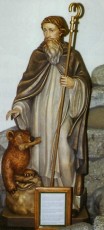Catholic Blesseds, Saints, Solemnities & Holy Days

Saint Gall
Feast Day: July 1
Patronage: Birds, Geese, Poultry, Sweden
When St. Columban was exiled in 610, Gall followed him to Switzerland and then to Italy. Gall remained in Switzerland and became a hermit on the Steinach River. The monastery of St. Gall was erected on this site. St. Gall refused to become a bishop twice, and an Abbot, and is venerated as an Apostle to the land, where he died in Arbon in 646. His focus was always on the learning of God and his ways, and not of the world.
After his death a small church was erected which developed into the Abbey of St. Gall, the center for theology training, in eastern Switzerland. The first Abbot of St. Gall Abbey was St. Othmar. The Emperor Louis the Pious made it an imperial Institution, “The Abbey of St. Gall”, not from the name of its founder and first Abbot – St. Othmar, but of the saint who had lived in this place and whose relics were honored there. It played a very important part in Catholic and Intellectual history until it was secularized in 1798.
Interesting stories such as; Gall delivered Fridiburga from a demon which she was possessed. Fridiburga was the betrothed of Sigebert II, King of the Franks, who in gratitude gave him land in Arbon, which belonged to the Royal Treasury – to build a Monastery, which eventually became the Abbey of St. Gall. Another popular story about St. Gall has it that, at the command of the Saint, a bear would bring wood to him to feed the fire that he and his companions had kindled in the Forest. For this reason, St. Gall is generally pictured with a “bear” beside him, usually with a piece of wood in his mouth. Legend has it that St. Gall made a pact of peace with a bear who was terrorizing the citizens of the nearby village. If they would feed him gingerbread, he would refrain from eating them. The legend is said to be a lesson in one making peace with his dark side, according to St. Gall.





